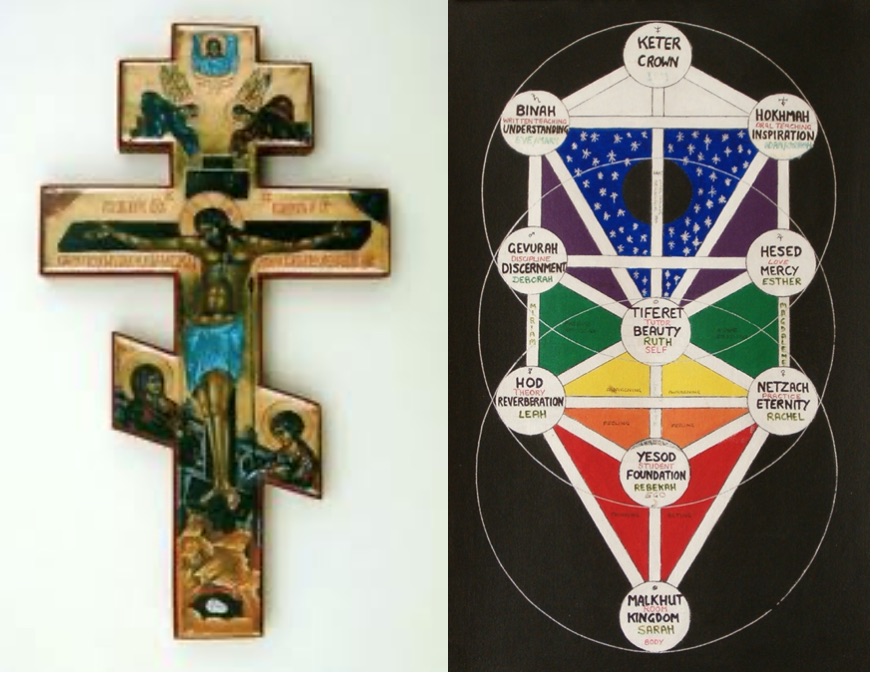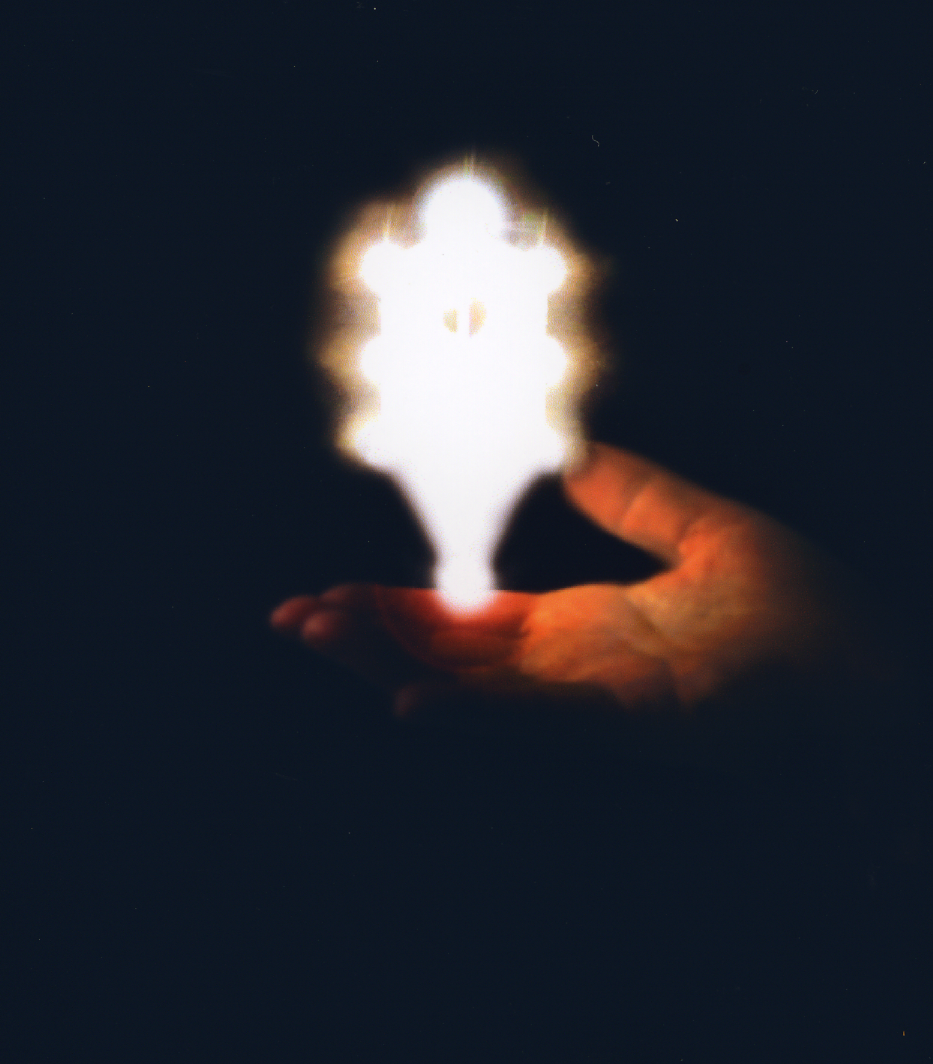
One of the magical things about studying Kabbalah is in learning how to read the Bible on four different levels. Literally, it’s a bit of a nightmare of slashing and burning and judgement but allegorically, metaphysically and mystically, the Bible is an extraordinary handbook for living—whatever your faith. The secret is in the spaces between the words.
Here’s an example: Hidden in the Gospel of Luke is a little story about the crucifixion which tells us everything we need to know about life in order to live happily. It’s the story of the three crosses.
This story is only in the Gospel of Luke because it reflects the metaphysical level of the Gospel. Matthew is the literal/historical Gospel, Mark is the allegorical/psychological Gospel, Luke is the spiritual Gospel and John is, of course, the mystical Gospel of Divinity speaking to and through us.
So, the four Gospels could perhaps be seen as a key to the code of how to read the rest of the Bible.
St. Irenaeus (died 202) wrote in his Against Heresies: “It is not possible that the Gospels can be either more or fewer in number than they are. For, since there are four zones of the world in which we live, and four principal winds, while the Church is scattered throughout all the world, and the pillar and ground of the Church is the Gospel and the spirit of life; it is fitting that she should have four pillars, breathing out immortality on every side, and vivifying men afresh.” So that might explain why only four Gospels were chosen for the Canon of the Church. It wasn’t that the others were deemed “wrong” they just didn’t show the universal pattern. Also, there is value in hidden things which the early Church Fathers also knew and taught, extensively. You’re meant to research to find out more but the basics are there right in front of you—as long as you know how to read them. In those days, people did know. We, unfortunately, have lost the knack.
As a quick example of the four levels, the account of the Exodus in the Hebrew Testament is the story of a physical escape from slavery, a psychological journey from the tribe into the wilderness of internal growth and on to happiness and freedom, a spiritual journey of realising that all the characters are parts of our own psyches and a divine journey of opening up to the Grace of God. Just knowing that makes the book easier to read—and far more inspirational.
This is the story of the three crosses (Luke 23:34):
Two other men, both criminals, were also led out with him to be executed. When they came to the place called Golgotha, they crucified him there, along with the criminals—one on his right, the other on his left. Jesus said, “Father, forgive them, for they do not know what they are doing.” And they divided up his clothes by casting lots … One of the criminals who hung there hurled insults at him: “Aren’t you the Messiah? Save yourself and us!” But the other criminal rebuked him. “Don’t you fear God,” he said, “since you are under the same sentence? We are punished justly, for we are getting what our deeds deserve. But this man has done nothing wrong.” Then he said, “Jesus, remember me when you come into your kingdom.” Jesus answered him, “Truly I tell you, today you will be with me in paradise.”
If you look at the picture of the Russian Orthodox cross next to the Tree of Life you can see, clearly, that there are three crossbars on both. Generally, folk assume that the bottom cross is for Jesus’ feet and the top one is for the ‘king of the Jews’ inscription and this may, literally, be the case. However, spiritually, the three crosses represent levels of being. The four levels of interpretation are in the spaces between the crossbars. Under the first crossbar is the physical/literal interpretation: that three men are being crucified. We know that bit so let’s move on…
The first man who wants Jesus to save them is at the level of ego (Yesod on the Tree of Life). The lowest bar on the Tree is known as the “liminal line”—the place where we have the choice to grow into our true self or to sink back down into ego consciousness. The latter is the normal state of humanity—reacting, blaming others and simultaneously wanting the others to save us. Nothing is our fault or responsibility and everything should be fixed for our benefit. The angle of the lowest crossbar on the Russian Orthodox cross would appear to be indicating that he is stuck on the wheel of life and destined to go round the circle again.
“Hang on!” You may be saying, “Suddenly, this is all Buddhist and about Karma and reincarnation? Where did the mystical Christianity go?”
Mystical everything comes from the same root and all the great stories follow the same Cosmic pattern of sacrifice and redemption. And just because we may not believe in reincarnation and/or Karma today means that our modern minds can be a big blocker to understanding what was believed and written then. You have to read the Bible and other spiritual texts in the light of what was understood at that time and many folk in Jesus’ day did believe in reincarnation.
Some say that group included the Pharisees. The somewhat disputed evidence for that is in The Jewish War, by the first century Jewish historian, Josephus, who wrote that the Pharisees believed: “the soul of the good man enters [eis heteron sōma]—“into another body” (singular).
Most scholars believe that Josephus is talking about here is a reconstituted, resurrected body we will receive on the last day—not a series of bodies received in different lifetimes during history but nobody knows for sure. And it is hard to interpret the line from the Gospel of John (9:2) as anything other than a belief in reincarnation: ‘As he went along, he saw a man blind from birth. His disciples asked him, “Rabbi, who sinned, this man or his parents, that he was born blind?”’ How could he have sinned before his birth if not in a previous life?
What many scholars do accept is that Josephus may have been cunning with his word-play as many folk in Greek and Roman society did believe in reincarnation and he was wanting them to relate to his work.
But even without the concept of reincarnation, the allegory in the teaching of the slanted cross-bar is pretty clear—the man is at the psychological level where he has a choice of being conscious (up) or unconscious (down). He demonstrates by his words that he is unconscious, has no concept of self-responsibility and has learnt little if anything that is of benefit to his soul in this life. Some might see the angle of the bar as saying he’s headed for hell but, in fact, the Bible really doesn’t have much to say about there being any hell at all, just an underworld; the hell doctrine got added into Christianity later. It’s my view, by the way, that when engulfing fires are mentioned in the New Testament, they are far more likely to refer to the healing and cleansing fires of Grace. Those can certainly hurt like hell (I say that from experience!), but they are ultimately transformative and never permanent.
The second man represents the middle crossbar, which is at the level of the soul on the Tree of Life (and yes, Jesus himself is depicted here in the picture—that’s because at the metaphysical, third level, we are all One so Jesus’ story is also our story). The soul is where we take full responsibility for our life. We may not have created a certain situation or sickness but we participated in a life where that became the inevitable result and we know that our response to the situation will direct its outcome. In this man’s case, he is totally clear that he did create the situation through his own actions and there is no one to blame. He knew the law and he broke it.
At the level of the soul, we are fully conscious and able to acknowledge our errors. We follow the true meaning of the word metanoia, which is usually translated as “repent” but more accurately as “think again/think anew.”
From the level of the soul we can both take responsibility (ability to respond not “blame”) and from there, ask for blessings to help us. The man asks Jesus to remember him when he comes into the Kingdom. Jesus replies, “Today you shall be with me in paradise.”
The final cross is the cross of Christ at the top of the Tree of Life. This is the cross that transcends the physical world, taking us into the Kingdom of God. The vertical pillar crosses the black hole known as Da’at which represents both death and transformation. The symbolism here shows us that when we (as Jesus earlier did) can understand that the majority (if not all) of the harm we perceive to have been done to us was done by people who are as unconscious as the first criminal, then we can transcend judgment. Even the second man made a mental judgment—that his punishment was fair given his behaviour. Once we can move beyond judgment entirely, we can forgive all things: “they didn’t realise what they were doing, so how can I condemn them?”
It’s not entirely likely that most of us will get to that mental state in our lifetime (or, indeed, in many lifetimes!) but we can all get to the second cross of accepting that our responses to the events life matter and are pivotal in what happens to us.
So next time we’re hanging on a cross of pain or blame or shame, let us all come to our selves, acknowledge that we had at least some hand in participating in where we have found ourselves and commit to accepting that. Then, we can ask for the Grace that is simply waiting to lift us out and into paradise.
Which cross are you hanging on today?

0 Comments